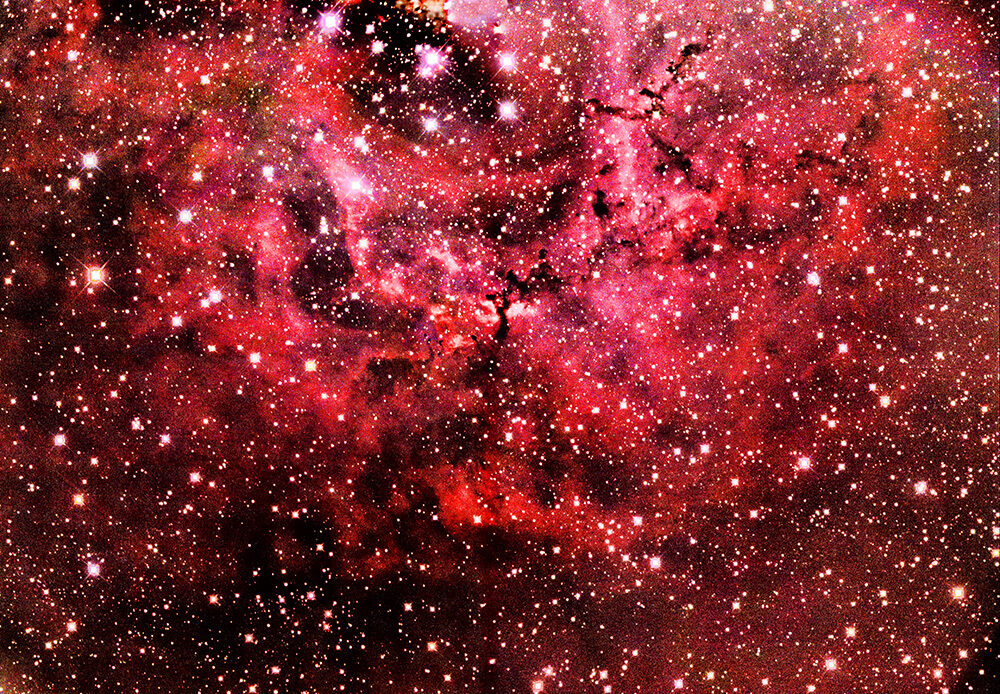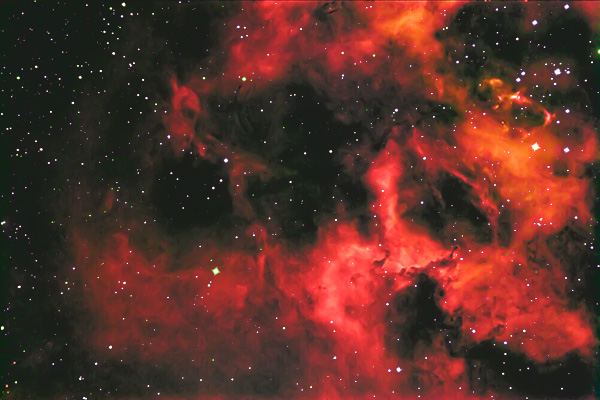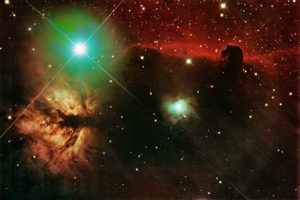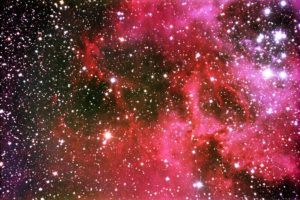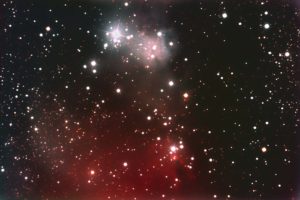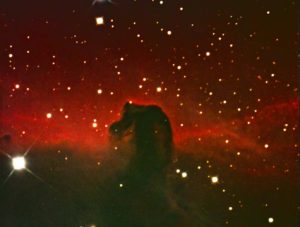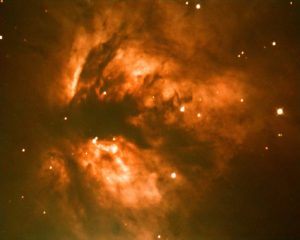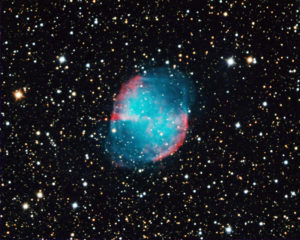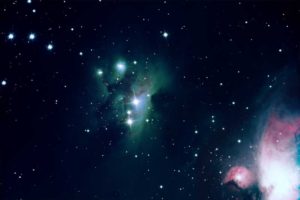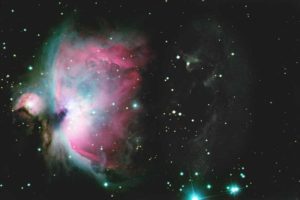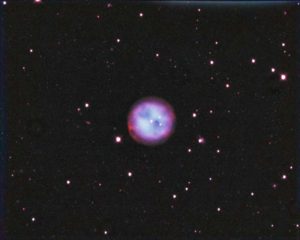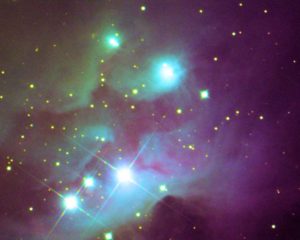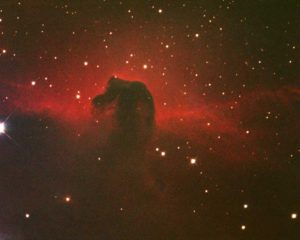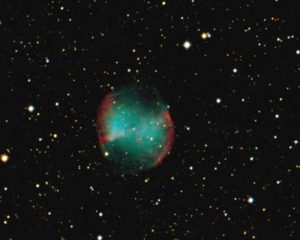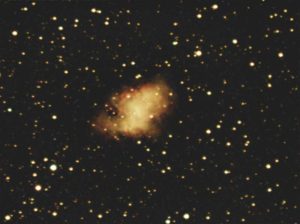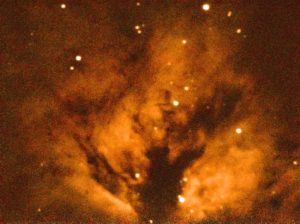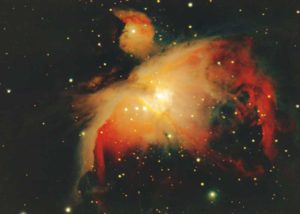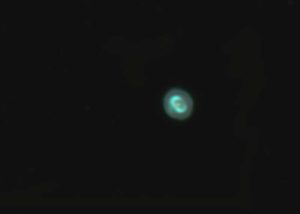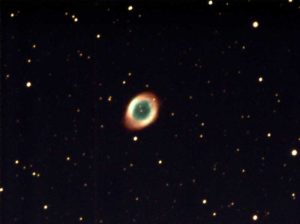Mosaic of half of Rosette nebula
With the equipment the camera can image just over a quarter of the nebula. In the time available two overlapping quarters were images each with the settings shown.
Each image was processed with star extraction and the star images were used to align, pasting the nebulae images as layers. Unfortunately the pervious image from 2022 could not be added as it was at a quite different orientation.
Settings
Date: 13-02-23
Camera: Trius Pro 35
L 300s x 20 (1×1). RGB 120 x7 (2×2).
Part of the Rosette Nebula Processed with Star Xtractor 12-12-22
This uses the data of 22-02-22 below, but using Star Xtractor the stars are first removed. This enables the nebula and the stars to be processed separately. In this way the dominance of the stars can be contolled and more of the detail of the nebula revealed.
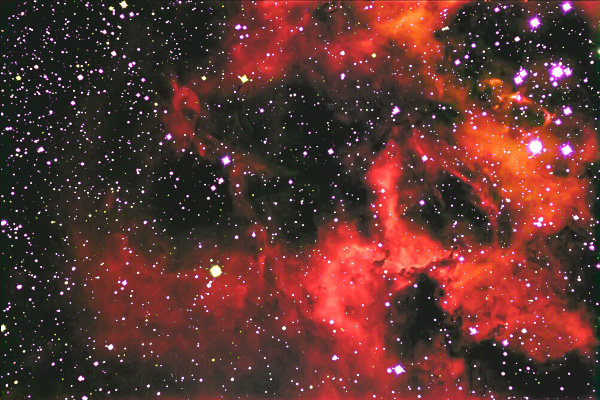
Horsehead and Flame Nebula
These nebulae are located close to Alnitak, the easternmost star of Orion’s Belt.
The Horsehead Nebula is approximately 1,375 light-years from Earth and the Flame Nebula is about 900 to 1,500 light-years away.
More on each of these nebulae can be found below where there are more detailed images of the separate nebulae.
Settings
Date: 22-02-22
Camera: Trius Pro 35
L 600s x 2 (1×1). RGB 300s x 3 (2×2). Unfortunately there was a slippage in the rotation of the camera which prevented more subs being taken.
Part of the Rosette Nebula
The Rosette nebula is approximately 5200ly from Earth with an open cluster of stars top right – which is near the centre of the complete nebula.
The open cluster (Caldwell 50) is closely associated with the nebulosity, the stars of the cluster having been formed from the nebula’s matter.
Settings
Date: 04-02-22
Camera: Trius Pro 35
L 300s x 20 (1×1). R 120s x 20 (2×2). GB 120s x 14 (2×2)
Cone Nebula, Christmas Tree Cluster and Fox Fur Nebula
This image was taken in adverse conditions. The Moon was nearly full and there was a lot of moisture in the air. The cone nebula is seen as a dark cone on the left of the image just below centre. It protrudes from the left edge of the image.
The Christmas tree cluster is the group of stars near the bright star towards the top. Even on images taken with bigger and better scopes it is difficult to see why this has its name.
It is just as difficult to see why the Fox Fur nebula is so called. It is the nebula near the bright star towards the top and also extends off the top of the image. Follow up will be to take this image again in better conditions, and to use the H694 camera to give close up images of the cone nebula and the Cluster/Fox Fur separately.
Settings
Date: 11-01-22
Camera: Trius Pro 35
L 600s x 20 (1×1). RGB 120s x 8 (2×2)
Horsehead Nebula Barnard 33
The Horsehead Nebula (also known as Barnard 33) is a small dark nebula in the constellation Orion with a distinct horsehead shape. This is a retake of an earlier to try improve definition.
The nebula is located just to the south of Alnitak, the easternmost star of Orion’s Belt, and is part of the much larger Orion Molecular Cloud Complex. It appears within the southern region of the dense dust cloud known as Lynds 1630, along the edge of the much larger, active star-forming called IC 434.
The Horsehead Nebula is approximately 1,375 light-years from Earth.
Settings
Date: 04-01-22
Camera: SX H694
L 600s x 10 (1×1). RGB 300s x 4 (2×2)
Flame Nebula NGC2024
The Flame Nebula NGC2024 is an emission nebula in the constellation Orion. It is about 900 to 1,500 light-years away. This is a retake to try to improve definition.
The bright star Alnitak (ζ Ori), the easternmost star in the Belt of Orion, shines energetic ultraviolet light into the Flame and this knocks electrons away from the great clouds of hydrogen gas that reside there. Much of the glow results when the electrons and ionized hydrogen recombine. Additional dark gas and dust lies in front of the bright part of the nebula and this is what causes the dark network that appears in the center of the glowing gas. The Flame Nebula is part of the Orion Molecular Cloud Complex, a star-forming region that includes the famous Horsehead Nebula.
Settings
Date: 20-01-20
Camera: SX H694
L 300s x 15 (1×1). RGB 120s x 5 (2×2)
Dumbbell Nebula M27
The Dumbbell Nebula, Messier 27 is a planetary nebula in the constellation Vulpecula, at a distance of about 1227 light-years.
.
See below for earlier image. This image is an improvement and was processed in Pixinsight to get the LRGB then further in photoshop to improve colour.
Settings
Date: 25-10-21
Camera SX H694
L 300s x 6 (1×1) RGB 120s x 6(2×2)
Running Man nebula
This image is taken with larger chip Trius Pro 35 so that it can be seen in relation to the “great nebula”.
The part of the great nebula is much brighter than the running man itself so could easily be oversaturated. The solution was to create a “curve adjust layer” which protected the brighter parts of the image while allowing further work with curves on the main part of the image.
Settings
Date: 21-01-21
Camera Trius Pro 35
L 300s x 5 (1×1) RGB 300s x 5(1×1)
Horsehead and Flame nebula
The bright star is Alnitak which is the left star in Orion’s belt. The new camera allows these two nebulae to be caught in the same frame and so produces a good range of colours.
This proved problematical. The autoguider was spot on all through. SGP was set to cycle through so the camera had to flip between 1×1 and 2×2. The resulting images dis not align despite the accurate autoguiding. Basically this is a mystery. Could it be due to flicking the binning between each frame, or could I have been autoguiding on as asteroid??
As a result the processing was a nightmare with the added problem of scaling the images to the same effective binning. Moral do not repeat this.
Settings
Date: 07-01-21
Camera Trius Pro 35
L 600s x 5 (1×1) RGB 600s x 5(2×2)
Great Nebula in Orion M42
This photograph was taken with the new Trius Pro 35 as a single frame. Compared to the previous image there are more details even though there is just one image. The colours are also quite different.
Two image were taken. The low exposure was used to provide a layer mask for the bright central regions. The long exposure was processed in stages to provide 3 further images for layer masking.
Settings
Date: 31-12-20
Camera Trius Pro 35
L 30s x 3 (1×1) RGB 60s x 3 (1×1) and
L200s x 5 (1×1) RGB 300s x 5 (1×1)
Owl Nebula M97
The Owl Nebula, M97, is a planetary nebula located approximately 2,030 light years away in the constellation Ursa Major.
The nebula is approximately 8,000 years old.[5] It is approximately circular in cross-section with a little visible internal structure. It was formed from the outflow of material from the stellar wind of the central star as it evolved.
The 14th magnitude central star has since reached the turning point of its evolution where it condenses to form a white dwarf. It has 55–60% of the Sun’s mass, 41–148 times the brightness of the Sun, and an effective temperature of 123,000 K
Settings
Date: 15-03-20
Camera SX H694
L 600s x 6 (1×1). RGB 300s x 2 (2×2)
Running Man Nebula – part of SH2-279
The Running Man is a reflection nebula embedded is a region of bright nebulae SH2-279.
Settings
Date: 20-01-20
Camera: SX H694
L 300s x 6 (1×1). RGB 300s x 1 (1×1)
Horsehead Nebula Barnard 33
The Horsehead Nebula (also known as Barnard 33) is a small dark nebula in the constellation Orion with a distinct horsehead shape.
The nebula is located just to the south of Alnitak, the easternmost star of Orion’s Belt, and is part of the much larger Orion Molecular Cloud Complex. It appears within the southern region of the dense dust cloud known as Lynds 1630, along the edge of the much larger, active star-forming called IC 434.
The Horsehead Nebula is approximately 1,375 light-years from Earth.
Settings
Date: 29-12-19
Camera SX H694
L 60 x 10 (1×1) + 600 x1 (1×1)
RGB 300s x 2 (1×1)
Dumbbell Nebula M27
The Dumbbell Nebula, Messier 27 is a planetary nebula in the constellation Vulpecula, at a distance of about 1227 light-years.
It was the first planetary nebula to be discovered, by Charles Messier in 1764. At its brightness of visual magnitude 7.5 and diameter of about 8 arcminutes, it is easily visible in binoculars. It was initially computed that its rate of expansion in the plane of the sky was no more than 2.3″ per century. From this, an upper limit to the age of 14,600 years may be determined. This was revised in 1970 when Bohuski, Smith, and Weedman found an expansion velocity of 31 km/s. Given its semi-minor axis radius of 1.01 light years, this implies that the age of the nebula is some 9,800 years from when the star eruption occurred.
The central star, a white dwarf progenitor, is estimated to have a radius which is 0.055 times the radius of the sun which gives it a size larger than most other known white dwarfs
Settings
Date: 02-10-19
Camera SX H694
L 300s x 6 (1X1). RGB 300s x 3 (1×1)
Crab Nebula M1
The Crab Nebula, M1 is a supernova remnant in the constellation of Taurus. The nebula was discovered by English astronomer John Bevis in 1731, and it corresponds with a bright supernova recorded by Chinese astronomers in 1054.
The nebula was the first astronomical object identified that corresponds with a historical supernova explosion.
The nebula lies in the Perseus Arm of the Milky Way, at a distance of about 6,500 light years from Earth. It has a diameter of 11 light years, and is expanding at a rate of about 1,500 kilometres per second or 0.5% of the speed of light.
At the center of the nebula lies the Crab Pulsar, a neutron star 28–30 kilometres across with a spin rate of 30.2 times per second, which emits pulses of radiation from gamma rays to radio waves. At X-ray and gamma ray energies above 30 keV, the Crab Nebula is generally the brightest persistent gamma-ray source in the sky. The nebula’s radiation allows detailed study of celestial bodies that occult it. In the 1950s and 1960s, the Sun’s corona was mapped from observations of the Crab Nebula’s radio waves passing through it, and in 2003, the thickness of the atmosphere of Saturn’s moon Titan was measured as it blocked out X-rays from the nebula.
Settings
Date: 02-02-19
Camera Atik Infinity
Colour 25s x 13 (1×1)
Flame Nebula NGC2024
The Flame Nebula NGC2024 is an emission nebula in the constellation Orion. It is about 900 to 1,500 light-years away.
The bright star Alnitak (ζ Ori), the easternmost star in the Belt of Orion, shines energetic ultraviolet light into the Flame and this knocks electrons away from the great clouds of hydrogen gas that reside there. Much of the glow results when the electrons and ionized hydrogen recombine. Additional dark gas and dust lies in front of the bright part of the nebula and this is what causes the dark network that appears in the center of the glowing gas. The Flame Nebula is part of the Orion Molecular Cloud Complex, a star-forming region that includes the famous Horsehead Nebula.
Settings
Date: 28-01-19
Camera Atik Infinity
Colour 25s x 13 (1×1)
Orion Nebula M42
The Orion Nebula Messier 42 is a diffuse nebula being south of Orion’s Belt. It is one of the brightest nebulae and is visible to the naked eye in the night sky.
M42 is located at a distance of 1,344 ± 20 light years and is the closest region of massive star formation to Earth. The M42 nebula is estimated to be 24 light years across. It has a mass of about 2,000 times that of the Sun.
The nebula has revealed much about the process of how stars and planetary systems are formed from collapsing clouds of gas and dust. Astronomers have directly observed protoplanetary disks, brown dwarfs, intense and turbulent motions of the gas, and the photo-ionizing effects of massive nearby stars in the nebula. It is mixture of emission and reflection components.
Settings
Date: 27-01-19
Camera Atik Infinity
Colour.
A composite of six areas due to its size and also layer masked taking the earlier stages of processing as the underneath layers. Exposures of 15s with stacks of 18.
Blue Snowball Nebula NGC7662
The Blue Snowball is a planetary nebula found in the constellation of Andromeda. It has a bluish colour and a central white dwarf star.
The distance of the nebula from Earth is 1,800 light years and it has a radius of 0.8 light years. The Blue Snowball nebula is dominated by the blue green light from Oiii, although the inner core of the nebula contains a fair amount of red light from Ha emissions.
Settings
Date: 08-01-19
Camera Atik Infinity
Colour 15s x 21 (1×1)
Ring Nebula M87
The Ring Nebula M57 is a planetary nebula in the northern constellation of Lyra.
Such objects are formed when a shell of ionized gas is expelled into the surrounding interstellar medium by a star in the last stages of its evolution before becoming a white dwarf.
M57 is 2,570 light-years from Earth. It has a visual magnitude of 8.8. Photographs taken over a period of 50 years show the rate of nebula expansion is roughly 1 arcsecond per century, which corresponds to spectroscopic observations as 20–30 km s−1. M57 is illuminated by a central white dwarf or planetary nebula nucleus (PNN) of 14.8 visual magnitude.
Settings
Date: 09-10-18
Camera Atik Infinity
Exposure and stack numbers not recorded.
